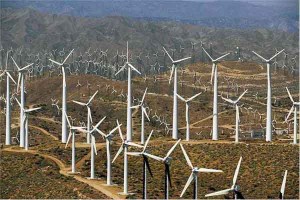 The Bonneville Power Administration, which transmits three-quarters of the electricity generated in the Pacific Northwest, is saying thanks-but-no-thanks to wind-power providers in the region. Wind farms are expected to go dormant, because BPA says their power simply isn’t needed.
The Bonneville Power Administration, which transmits three-quarters of the electricity generated in the Pacific Northwest, is saying thanks-but-no-thanks to wind-power providers in the region. Wind farms are expected to go dormant, because BPA says their power simply isn’t needed.
Why? Because of this winter’s unusually heavy snowfall. That snow is melting now, surging downhill and into the water shed, and eventually through the region’s numerous hydroelectric dams.
The dams are already producing as much electricity as BPA can sell. Wind power simply isn’t needed.
Not needed in the Pacific Northwest, at any rate. On the other side of the country our electricity is generated, for the most part, through the burning of coal. That’s a non-renewable source that’s doing catastrophic environmental damage in every stage of its production: mining, transportation and utilization.
The ten percent or so of our power not coming from coal mostly comes from nuclear-turbine plants. That’s a zero-emissions source, unless you count spent fuel rods as an emission. Those remain highly radioactive for thousands of years, and we can’t even find a way to dispose of the millions of tons of them already produced.
And the nuclear plants themselves? Totally safe. Unless there’s an earthquake. Or a terrorist attack. Or the cooling pumps break.
The insanity of idling wind-power farms can in no way be interpreted as an indictment of renewable energy. Renewable energy is still the only logical way to sustain a technological society for more than a handful of generations. To overstate the obvious: the coal (and oil, and gas) won’t always be there. But the wind will.
The real culprit is the age and insularity of our power grid. The grid is regionalized, so that even if BPA wanted to move their excess power east, they couldn’t. It’s physically impossible. And our grid is ancient, by tech standards. Its design and many of its elements date back to the late 1940s.
A new grid is not only feasible, its design has been in the works for decades. It’s called Smart Grid, and it would leverage digital technology, and nationwide integration, to gain the maximum possible efficiency in the generation, transmission and use of electricity.
It would also cost anywhere between $100 billion and $2 trillion to implement.
That sticker shock is why Smart Grid remains hypothetical. It’s why even tepid Smart Grid research and development is inevitably the first thing to go in every round of budget cuts.
That’s a lot of dough, no doubt about it. Quite a few would even argue that we simply can’t afford it. But it seems to me that with a grid as old as ours, we’re going to be replacing it anyway, sooner rather than later. We can replace it piecemeal, as disparate elements of it wear out and break down…
Or we can use the best technology we have, to create a grid that’s efficient and effective. And we can stop shutting down wind farms just because it snowed too much.